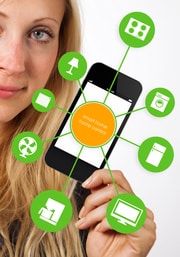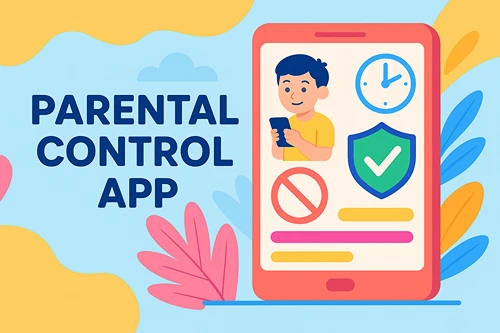Navigating Smart Technology in the Home
Smart technology is becoming the norm rather than the exception, with more and more gadgets helping make our homes more efficient. This technology can help make our lives more convenient, and our kids’ educational experience more enriched.
Smart tech can add an extra measure of safety in our homes, but parents also need to be aware of potential security risks. Here’s an overview of things to consider when adopting smart tech into your home.
Teaching smart online behavior is key.
As smart devices are becoming more integrating into your child’s life for entertainment, education and daily living, it’s important to teach them about safe online behavior. Older kids who are on social media should know why privacy settings are important. They should be selective about accepting friend requests and ensure location services are disabled. They also should understand the perennial nature of posting, and how nothing on social media is ever really gone.
Ensure your pre-teens and teens understand the nature of cyberbullying. This includes understanding that photos and situations that are funny to them now, might lose their humor down the line because they can hurt people’s feelings. These posts might come back to haunt them later when they want to join a club, get an after-school job or apply to college.
They also should understand that posting about an event or activity on social media can cause resentment by those who have been deliberately left out, helping them to think critically about what they wish to share publicly.
Smart sensors in the home make sense.
A smart home can incorporate many different types of smart sensors. Some are particularly useful for keeping kids safe, especially for curious toddlers who haven’t yet learned about boundaries. Sensors installed in doorways can create greater peace of mind for parents of small explorers. For example, they can send a signal to your phone when a child exits a threshold, or if an intruder enters one.
Sensors can connect to a video camera so you can check your phone to see what’s happening. Doorbell cameras are particularly useful for when your kids get older and start inviting the neighborhood over when you’re not home.
Among the various types of sensors a home may have, motion sensors can be set up around danger areas, such as swimming pools or driveways, to provide a notification to you when a child has entered the area unsupervised. Window sensors can not only help save energy but can create an extra measure of safety by notifying you when one is left open or opens unexpectedly, ensuring there are no unexpected escapes or entries.
While every home should be equipped with smoke and carbon monoxide detectors, smart versions of these devices can also monitor your home’s air quality, checking for pollen and other particles that can be troublesome for young lungs.
Smart light bulbs can improve school performance.
Smart tech in your home can include smart light bulbs, which can help your kids get better grades in school. How? For one, some smart bulbs can adjust their blue light emissions from day to evening, helping your kids be more energized in the mornings and move more easily toward sleep at night.
Blue light, which comes to us naturally through sunlight, can interfere with the sleep hormone melatonin when we get too much blue light artificially. Better sleep equals better performance at school and on tests.
It’s important to recognize that every person’s experience with sleep issues is different. Managing the challenges can be both frustrating and isolating. Studies have shown that different colors of light can promote sleep by examining the effects of light and habits that may improve sleep. Determining which are the worst colors for sleep is also key in helping parents determine which colors are best for their kids.
Smart devices can protect infant safety.
Parents of newborns already know the important benefit of baby monitors in keeping an ear on activity in the other room. The frightening worry posed by SIDS, or sudden infant death syndrome, has led developers of baby monitors to evolve the product. Some connect to your smartphone or can be sent to a mobile speaker.
Other smart items like onesies, mattresses or socks can measure and monitor your baby’s vital information like heart rate, breathing, movement, pulse oximetry and body position. You will be able to hear sounding alarms or receive notifications to your phone when there’s a problem.
Internet-connected smart toys need vetting.
Smart toys with an Internet connection—which can include robot dogs, dinosaurs, cars and other items—should be carefully vetted before purchase or forgone altogether. Many of these toys have cameras and microphones and can gather data during play as well as share your child’s location.
While these toys can provide educational opportunities, the Federal Trade Commission urges parents to carefully collect information on the toy before purchasing. That includes researching what kind of information the toy will collect about your child, learning of there are security issues or safety recalls, and knowing whether there have been security complaints.
Know the features of the toy and when it will be listening in, and whether you have the option to control the information. Smart toys, just like any other smart item in your home, pose a risk of being hacked or their data used in ways you didn’t expect.
Pros and Cons of Smart Home Technology
The impact of smart home technology is evident throughout our world today. It’s is used in homes in varying degrees. It helps save money and time for home security and safety, while intriducing new security challenges.
Some of the most common benefits that smart home technology are:
Customized Preferences & Settings
No matter which device you have, smart products can adjust to match any specific user’s customized preferences or needs.
Health & Wellness Tracking
Checking in on your health provides reassurance regarding safe and independent living. Adding smart technologies like a Wellcam facilitates real-time, two-way audio and video communication.
Energy & Utilities Management
Lighting, heating, and cooling can save on energy costs. Consider smart outlets to manage auto shut-off for electronic devices. Smart LED bulbs enable users to turn lights on and off at certain times for security and convenience.
Easy & Interconnectivity
Implementing smart home products is also convenient for monitoring many home-bound systems. Such interconnectivity enables users to manage and monitor thermostats remotely, review surveillance camera footage, and more, all without leaving their workplace—or even their kitchen table.
As much of a great benefit and commodity is to have these features at home, this can have crucial drawbacks such as:
High cost and skill requirements
The utility of smart devices comes at a steep price — compare a conventional and a smart fridge. A regular fridge costs between $1,000 and $2,000, while a smart model can have a price tag between $2,000 and $4,000.
Cybersecurity risks
Remember that these electronics collect large volumes of data and information, some of which are personal and sensitive. For example, your phone contains passwords, and your car’s global positioning system monitors your location.
To prevent hacking into your smart devices, ensure they’re equipped with anti-tampering and endpoint protection solutions. Implementing encryption protocols is recommended for protection, so hackers won’t be able to infiltrate a smart device or intercept its data.
The Bottom line
Smart home technology has evolved throughout the years; this has been a rapid and beneficial solution for everything surrounding us. From automating your kitchen and common areas to installing sprinkler systems and even viewing guests arriving at your front door has been quite convenient when having a smartphone.
Smart technology has great potential to improve safety and enhance kids’ lives when approached carefully and sensibly. Talking with your children and teaching them about the proper use of smart technology will help ensure the best experience for everyone.






